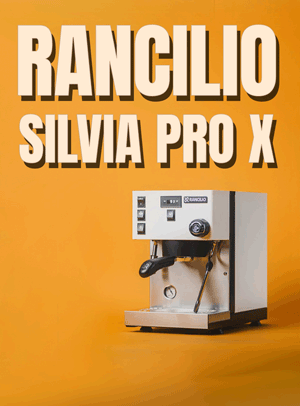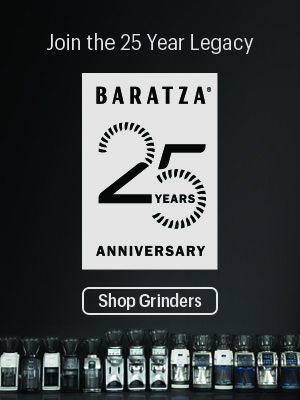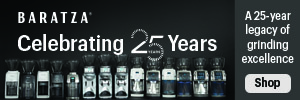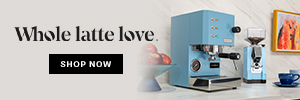Jim Schulman reports in from a day long meeting at Intelligentsia Roasting Works, 1850 W. Fulton Street in Chicago (website) (photos by Bearhair, a CoffeeGeek member, and Jim Schulman). Doug Zell, head honcho from Intelligentsia, organized the meet and greet as a way to do two things – let a group of advanced amateurs learn more about the professional business of coffee, and let a group of professionals learn something from a group of advanced amateurs. Here’s Jim’s report.
Part 1 – A Promising Collision in the Coffee Wasteland
A vintner will carefully select the vinyard’s best grapes for the reserve, a wine for special occasions. The grapes that don’t quite make the cut go into “second labels,” which are served with fine meals, while the merely ordinary grapes go to winemakers who make everyday table wines. With the growth of wine awareness, great wines’ prices have skyrocketed, but from the consumer point of view, this is more than compensated by the almost annual quality increase at every price point. Because the wine market rewards quality, vintners and winemakers strive to improve, and the result is a golden age for wine lovers at every budget.
With coffee, the situation is sadly different. Most great beans go unnoticed and untasted; they are mixed in with inferior beans by export monopolies, and sold in vast lots to mass market roasters. This entrenched marketing chain is creating a deadly downward spiral. Producers get less and less money for their crop, making quality impossible; consumers get worse and worse coffee and eventually switch to other drinks. If coffee lovers cannot create an alternative way to bring producers, roasters and drinkers together in a market that rewards quality, the coffee industry will collapse under the weight of its own mediocrity.
This is a story about a collision between two groups of coffee lovers with very different reactions to this crisis. The first are roasters and coffee shop owners, members of the Specialty Coffee Association of America (SCAA) and its counterparts in other lands, who want to buy, roast, and sell the world’s best coffees. The second are amateur coffee fanatics who have opted out of the supply chain altogether, in order to roast and brew their personal versions of the world’s best coffee at home. They don’t have an association; instead they communicate via the alt.coffee newsgroup, a handful of websites like Coffeegeek, and email lists maintained by green bean suppliers.
It began with one of the usual alt.coffee laments about the coffee wasteland. “Is there any good coffee in Chicago,” asked Steve Fiete, “I’ve had Intelligentsia’s (reputedly Chicago’s best) at restaurants and supermarkets, and I wasn’t impressed.” Several other Chicago based alt.coffee regulars, including me, piled on; the espresso wasn’t good, they’d grown too fast, etc. etc. Then something unusual happened. Doug Zell, the owner of Intelligentsia responded. He defended his beans and roasting, and added that he was upgrading Intelligentsia’s espresso blending and making to bring them to the same high standard. He invited all the alt.coffee participants (collectively known as “alties”) to an “espresso-in” at his roast works so they could judge for themselves.
I visited the roasting works in preparation for the espresso-in, and very quickly realized that we alties had misjudged Intelligentsia. Doug, Geoff, Intelligentsia’s roaster and coffee buyer, and the rest of the staff, were coffee fanatics doing what they loved as well as they knew how. And that was very well indeed; I learnt more in my few hours there than I had in my year of roasting coffee at home. Fortunately, the reading I had done on alt.coffee and the other sites had prepared me to digest what I was shown. My impression was reinforced when I homeroasted and sampled some of the greens I got during my visit. Intelligentsia gets these through direct personal relationships with coffee planters, an innovative arrangement that many of the best roasters are pursuing to raise coffee standards. These beans had the beautiful preparation, and the individualized, concentrated flavors of reserve wines. They equalled or exceeded the best greens I get from the superb vendors who supply home roasters.
The negative reactions from alties had been due to three factors; restaurants often prepare the coffee poorly, supermarkets will empty the roast dated Intelligentsia bags into bins when unsold coffee gets old, and the Intelligentsia coffeeshop had not been up to snuff in it’s espresso making practices. The espresso-in was partly about fixing the third item, more on the first two below.

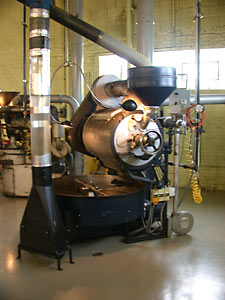

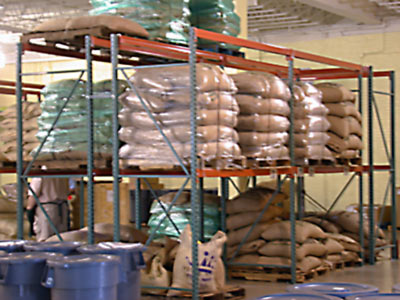
Here’s Butch Burton, another altie, on what he saw:
“The first floor had very efficient rack storage for green beans-not a single bag touching concrete-except one for 2 hours-it was holding the door open. The floors/walls were painted with a very pleasing pallet of colors and the lighting level was not the typical warehouse-but high enough to work without shadows. Did not see a single suggestion to enhance this facility-oh I design/sell storage systems for hospitals.
“The 2 roasters were about 50 years old (Ferd. Gothot – love that name) for a reason. The drums are made from cast iron and the mass of the cast iron drum along with the type of burners helps maintain even heat and reduce the risk of scorched beans. The chief roaster, Geoff, told us how he varied the roast process with the many inputs he controls to accomodate the differing weather and bean types. They had 20+ different large, covered trays with the roasted beans on a large table-checked the beans out and the roaster knows his stuff-just a hint of oil on beans with the exception of a couple of types which are notorious oil producers. The roaster was also able to offer some insight into the properties of the typical fluid bed/air roaster versus drum roasters.
“Also walked around checking out the bean bags for specific producer ID’s-lots of familiar names of quality producers here which I recognize from 3 years of buying beans from Tom and BJ [ed. note: Thompson Owen and Barry Jarrett, the owners of Sweetmaria’s and Riley’s Coffee, two premier green bean suppliers to home roasters]”
It turns out that Doug was equally impressed by us alties; we were, in the words of Mike Ferguson, the SCAA marketing director, “for those of us in the specialty coffee industry, almost mythical creatures, true connoisseurs whose relationship with coffee is not necessarily bound to the economic practicalities of running a business.” From their point of view, the demand for quality must start with the coffee drinker; without that, companies like Intelligentsia remain rarities, since their quality is a result of the passion of the owner and staff rather than the logic of the market. So Doug, a SCAA board member, wants to create a better market by fostering connections between quality roasters and coffee connoisseurs. The recent move by the SCAA to create a consumer member category is one result; the espresso-in another.
Doug Zell is an ambitious man, in an entirely good way. If his ideas work out, people will send back poorly prepared coffee at restaurants in the same way they send back an overcooked steak now; and they’d react to a supermarket’s attempt to pawn off stale coffee in the same way they react to the sale of expired milk now. I must say that this possibility makes more sense to me than my initial post suggesting that good roasters should avoid marketing their coffees widely, for fear of mishandling. After all, if good roasters don’t sell their coffees as widely as freshness allows, who will?
Pulling a perfect espresso is as technically demanding as making a perfect souffle. It’s not just a matter of ingredients, but also of a practiced and meticulous attention to detail and timing; without these the souffle is a gelatinous mess, and the espresso an emetic. The difference is you give the restaurant an hour’s notice for the souffle, and they charge you an arm and a leg; whereas you expect to get your reasonably priced espresso in a minute or two, especially when the rush is on. Therefore, it’s no surprise that the overwhelming majority of good espresso in North America is made in the homes of coffee lovers like the alties; a coffee bar that follows the nearly universal practice of hiring low paid, poorly trained, high turnover staff doesn’t have a snowball’s chance in hell of turning out good espresso.
The prophet of this creed is David Schomer of Cafe Vivace in Seattle. Espresso shop owners can “schomerize” their espresso making by following his recommendations in hiring, paying, and training staff, and in the details of the work flow. Not everyone agrees with his recipe for good espresso, and most will work out their own style; but when it comes to quality control, Schomer is gospel. Doug had trained his Baristas in this style and they were pulling the shots at the espresso-in.
If I hadn’t seen it with my own eyes, I wouldn’t have believed it. Initially, I was rating the different blends on the basic hallmarks of a well prepared espresso shot — crema, sweetness, and body — but I soon stopped. Each shot was virtually flawless in these areas; they were all shots I would have been proud to have pulled myself, and killed for at an espresso bar. The entire training program will be completed by August. Needless to say, the Intelligentsia cafe on Broadway will then become one of North America’s espresso cathedrals.
The amazing single shot grind and tamp La Marzocco Swift helped; but it didn’t automate the process. It left the Baristas (everyone working the machines on Saturday richly deserved the title) precious time to take care of other details. All shots were timed and observed for stream color, the PFs and groupheads were regularly flushed, overworked and undertemp machines were given a rest. The triple basket 1.5 ounce ristretto shots that Doug had instituted are particularly unforgiving of any deviation in shot time or temperature (I don’t attempt them at home), yet out of the roughly 200 espressos that were pulled, I heard only one being questioned by the drinkers. The baristas did all the necessary quality based rejections for us.
Without this level of barista virtuosity working in the background, it’s impossible to have an espresso tasting and blending session. Espresso is concentrated to the very edge of palatability. Done right, the distinct flavors are more individualized than in regular coffee and one can focus on creating interesting blends; but done wrong, it’s a flavor cacaphony where even the idea of blending is a joke. Often, when I have some touted brand that turns out to be nothing but Brazil with a smidgen of something else, I know it was tasted in poorly made shots, and designed to be as inoffensive as possible. The other props for a tasting and blending session are the same as for regular coffee: a wide selection of properly roasted single origin beans, accurate scales, mixing bins, cupping forms, and lots of water and water crackers (Matzah) to cleanse the palette.
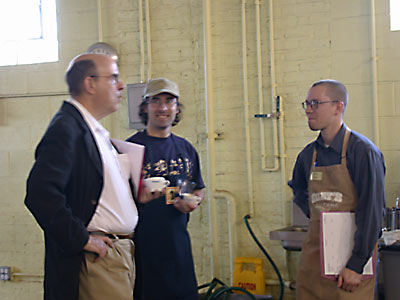
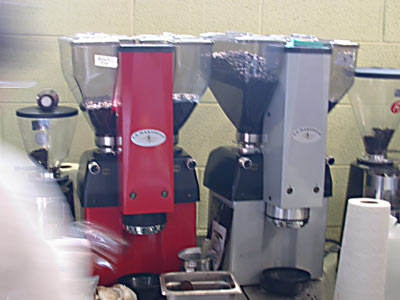
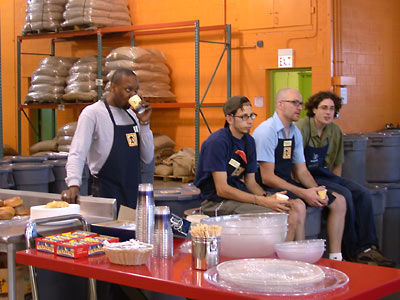
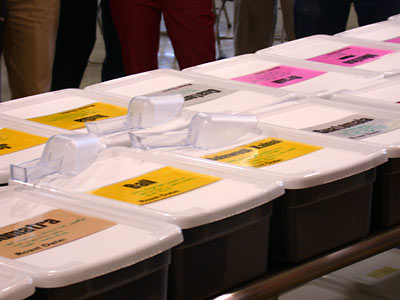
Part 3: Seventeen Monkeys Blending
Unfortunately, Tom of Sweetmaria’s couldn’t make it. His “Monkey Blend” is the oldest and probably most famous green bean espresso blend for homeroasters. The name derives from his humorous mental image of how most espresso blends are arrived at, via a monkey tossing beans around. If he had seen us rushing around and mixing beans, he surely would have been reminded of it.
Monkey blend also comes up in another way. It is a perfectly balanced blend with lots of flavors, none of which stand out or dominate; drinking it is almost like hearing a full orchestra playing a mellifluous chord. This is great for the beginning home roaster/ blender, since it gives her or him a beautiful platform on which to add a personal flavor note by blending it with, say, 25% of their favorite bean. But for a commercial blend, this level of balance is undesirable; instead, one is searching for a flavor profile with some unique, and instantly identifiable dominant notes, a concerto with some lead instruments, rather than a just an orchestra.
Intelligentsia’s Black Cat Blend had achieved this goal. It stars a superb Indian Pearl Mountain with a delicate orange zest and cardamum flavor, and is backed up by a band of Brazilian for sweetness, Sumatra for body, and Panamanian for a mellow middle tone. The flavor, when brewed above 200F (the Panamanian and Brazilian disappear at lower temps), is very tasty and distinct; moreover, the Indian’s cardamum notes shine in a cappucino. Our only niggle was that it might need an extra hint of sweetness.
The Oromo blend was a different story. Here the lead players had shown up, a bright and berry fruited Harrar clarinet and a pair of kettle drums from Java and Sumatra, but the band was AWOL, there were no middle tones at all. Everyone agreed that the proportion of Harrar needed to be cut, but nobody could agree on what sort of middle was required. To confuse matters further, we were thinking of Oromo as an “after dinner” espresso, but it turned out that everyone had different ideas about what that meant.
So off went the seventeen monkeys — Joel, Amanda, Mark Smutek, Steve Fiete, Deppity Bob/Buck Turgidson, Chris The Lurker and his wife Suzanne, Tom Jonker, Chris Beck, Gonzo, Doug Cadmus, Barry Jarrett, Jim Schulman, Bernie Digman, Madeleine Page, Andrew Timko, and Butch Burton (thanks Bearhair) — to see what they could blend.
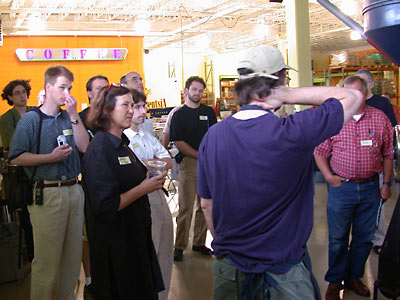
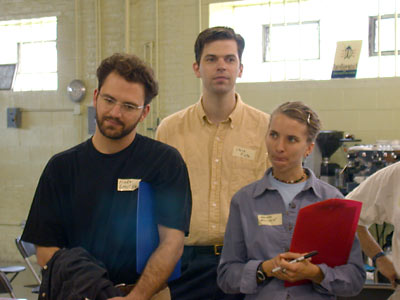
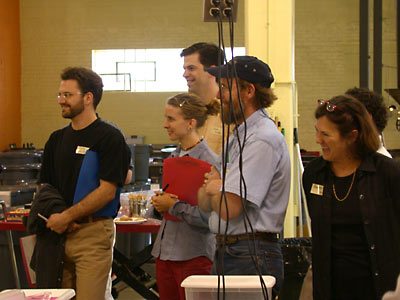

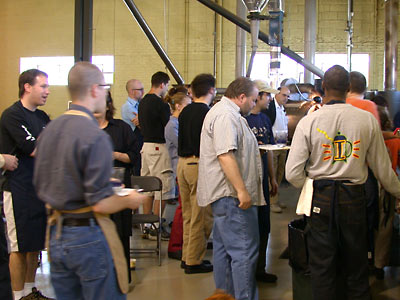
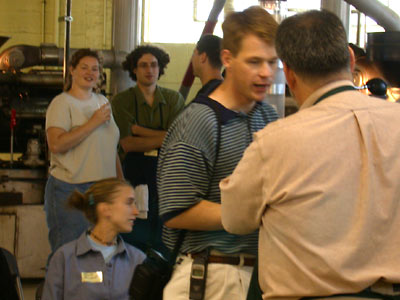
Actually, this characterization is not quite fair, Barry Jarrett and Bernie Digman, both professionals, as well as Doug Cadmus and Gonzo (Chris Shaeffer), who are close to being professionals, tried to lend the proceedings some structure. The result was that we ended up with only six candidate blends rather than the thirty six I was half expecting. Even more amazing was that two blends garnered almost all the votes (both in a best to worst, and in a straight voting format).
Part 4 Tasting Ironies
When we discussed the tasting just before lunch, Barry Jarrett and I got into an argument about blends 3 and 6, the two winners. My take on the after dinner espresso is that it’s a variant of the classic Mocha Java demitasse. Blend 6 (10% Yemen, 20% Harar, 30% Budadiri, 20% Java, & 20% Sulawesi), with 8 best votes, and strong dark chocolate and liqueur flavors was right up that alley. To Barry it was way too wild, and had too many beans for commercial viability (the second point is obviously true). Barry’s take on an after dinner espresso is that it should be pallette cleansing, fresh, and pleasantly sweet. Blend 3 (20% Harar, 30% Panama, 20% Brazil, and 30% Sulawesi), the first round winner with 9 best votes, and a milder, sweeter, and cleaner milk chocolate and cinnamon flavor, fit that bill very nicely. I argued that it wasn’t really an after dinner drink, and that it was boringly indistinct.
We agreed to break for lunch and try them again, blind this time. The blends were mixed, Geoff took them out and labelled them A & B, and we lined up at the machines to taste them. I had no trouble identifying which was which, but I still was scratching my head in puzzlement. I suddenly liked A (blend 3), in fact, I liked it so much that I switched my vote. Others were scratching their heads for the same reason, and to everyone’s amazement, Barry was one of those switching his vote. In this second round, blend 6 won 10 to 7, but the competitive aura had dissipated. All the tasters felt that it had become an apples and oranges thing — both blends were good, but quite distinct.
Now I’m wondering whether it’s as simple as those eating tuna for lunch preferring the lighter espresso, while those having roast beef going with the heavier one. In any case, it’s a cautionary lesson for anyone seeking “the perfect espresso.”
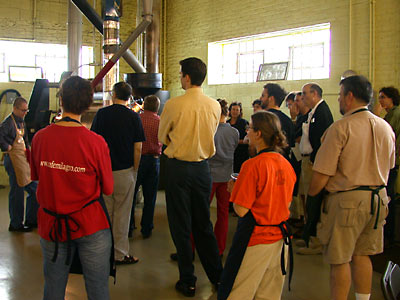
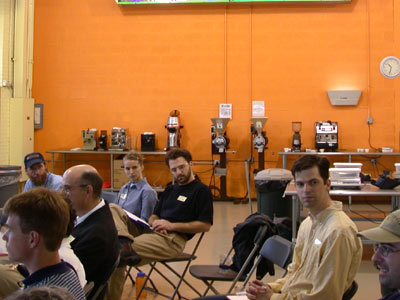
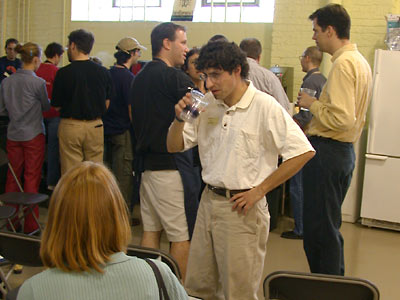

Part 5 – A Grand Finale
At this point we were espressoed out and abandoned our good intentions of refining the winning blends and trying them on a representative collection of home machines (kind readers, I know that we should all die for neglecting the Sylvia versus LM Linea showdown, but while the spirit was willing, the tastebuds were dead). Instead, we talked and got to know one another in person. We also sampled June Jarret’s fudges (forget Naples, get some of these, especially the maple, before you die). Then we watched Doug and the assembled baristas put on a latte art demo. Finally it was time to wrap up and leave.
We thanked Doug and his staff of coffee enthusiasts for giving up their weekend and giving us the red carpet treatment, I would like to reiterate that thanks here — just read between the lines of this article, and you’ll understand how much effort was put into making this a success. In turn, Doug delighted us by saying he intended to make this coffee fest an annual event; although the focus may change year to year between espresso and other forms or origins of coffee. We even got a set of Intelligentsia espresso cups and all the coffee we could carry.
Then came the big surprise. La Marzocco and ESI (their US branch) used the occasion to present Barry Jarrett with the awesome Swift Grinder.
Madeleine Page described the moment: “Seeing Barry get the news of the grinder-gift was a memorable moment. He looked like a kid on Christmas morning who sees the brightest, reddest, fastest bike in the world under the tree. He just *sparkled* and stood quite still, getting pinker and sparklier by the second. Lovely.”
The world knows Barry as a coffeeshop owner in downstate Illinois. But to coffee lovers, he’s one of the beacons of the coffee world – a seller of awesomely good coffees and blends, and one of the great espresso pullers. But apparently he has another side less people know about; he can improve on even very good espresso machines. The gift was in recognition of the work he had put into improving the Linea, work which is reflected in the quality of the current models. (About that Sylvia, Linea showdown, I don’t think it would have been a contest). Doug passed on the message that ESI expected him to pull the Swift apart and give them some tips on how to tweak it as well. Hey Barry, how about six hoppers on a carousel at the top? It would make the next espresso-in a lot easier!
Part 6 – A Personal Conclusion
What struck me the most was the shock of recognition. The decline in coffee quality had turned me into a home roasting coffee hobbyist, suspicious of people in the business. It had probably made people like Doug and Barry equally suspicious about the coffee taste of the public. Then we meet, and it’s almost instantly clear, these people are like us, they love coffee, it’s one of the great pleasures in their lives. I’m a pessimist by nature, but Ithink Doug is right; only good things can come from creating closer and more regularized ties between the coffee hobbyists and connoisseurs like the alties, and quality conscious roasters like Doug and Barry.









